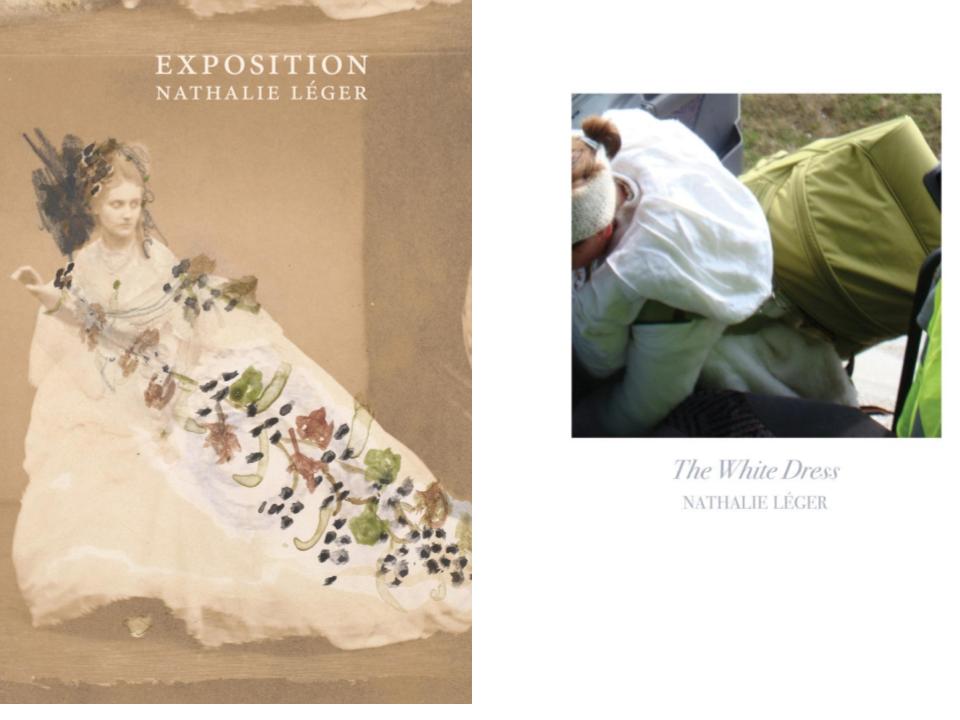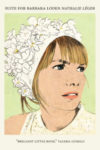
[Dorothy; 2020]
Tr. from the French by Amanda DeMarco / Natasha Lehrer
After the triumph of 2016’s Suite for Barbara Loden, which we’ve reviewed previously, Dorothy are bringing Nathalie Léger’s other two books into English this year: Exposition and The White Dress. But what are they?
Well, Exposition, Suite for Barbara Loden, and The White Dress are three books by Nathalie Léger. They are, respectively, the twenty-first, the thirteenth, and the twenty-second books published by Dorothy, a publishing project. They are originally written in French, released in 2008, 2015, and 2018, translated into English in 2020 by Amanda DeMarco, 2016 by Natasha Lehrer and Cécile Menon, and 2020 by Natasha Lehrer again. Outside of these bald facts, it is difficult to say. Like Léger in her writing, her books refuse simple description.
Léger herself uses the word project: a plan. But also, to project: to extend. Or, as a projector: to display an image, enlarged for an audience. And there is also the American colloquialism of a project as public housing, as a place where people live, often because they cannot live elsewhere. All of these definitions fit, and fit better than novel, memoir, essay, though these words have their places. Léger as well uses the word triptych to describe the books together. Everything fits inside these books, slim as they are; also, nothing fits, not together, not perfectly. This slipperiness of form is, I think, part of the appeal.
In January of this year, back when we were still able to do such things, Léger gave what was advertised as a “visual lecture” at the Triangle Arts Association in New York City on two of the books in her triptych, Suite and White Dress. Another word we could use to describe her books, and also this lecture: a performance — a word with internal resonances to the content of each book. She sat at a table in the front of a room with three assisting performers at another table to the side; each of them had a lamp with decorative paper shades pointed down at scripts in front of them. The performance began with the room’s lights going off and Léger’s lamp coming on. Dark except this golden light on the white page. She narrates: “There are two women.”
Each of Léger’s books take a subject. Ostensibly, these are: the Countess of Castiglioni, the most photographed woman in the 19th century world, in Exposition; Barbara Loden, director and star of the enigmatic and well-beloved (at least, by the avant-garde) movie Wanda in Suite for Barbara Loden, and Pippa Bacca, a performance artist (maybe) who was murdered in the process of her most famous piece in The White Dress. Léger herself is an archivist and curator, having curated exhibitions on Roland Barthes and Samuel Beckett, and acts under both these roles (among others) for the subject of each book: she archives and curates information on her subjects for the reader, and for herself. Each book is driven by obsession: Léger wants to understand not just the subjects for who they are, but wants to understand her own attraction to them, and why she feels she exists through them. What she writes about Barbara Loden’s project in Wanda, based itself on the real story of a woman who thanked a judge for sending her away, is applicable to her own: “a miniature model of modernity, reduced to its simplest, most complex form: a woman telling her own story through that of another woman.”
A projector is turned on. We see an early shot from Wanda: the white figure in the distance walking over a sea of coal. It’s an alluring shot — it’s impossible not to write about it, if writing about Wanda. Then the projection changes to two feet walking, not entirely steady. We hear the sound of the asphalt crunching underfoot, and the sound of cars passing by. Léger narrates: “Everyone here knows the story of Wanda, but nobody here knows the story of Pippa.”
And this is true, for the room we were in, as becomes apparent during the Q&A: Is this a real story? Yes, this is a real story, these are real videos, her videos: Pippa Bacca set out to hitchhike across Europe in a wedding dress in order to save the world. The rules of her journey were strict: she would never refuse to get in a car, she would only hitchhike. She had an itinerary. She would not take off the wedding dress.
Some weeks after she set out, her body was found in a shallow grave. She had been raped, and then strangled to death. Léger writes, “The point isn’t whether she failed or succeeded, the point is she died from it.”
Each book’s subject is a subject before Léger makes takes them as such. Castiglione was the subject of hundreds of photographs, estimated to be more than Cindy Sherman took of herself. Wanda is Barbara Loden’s subject, and Barbara Loden has been a subject for many writers — one could make a pantheon of those who have written of Barbara Loden, and so erect statues to Marguerite Duras, Kate Zambreno, and now Leger herself. Pippa Bacca, by the time Léger writes of her, had been the subject of a media frenzy that painted her alternately as a modern day saint or a naïve waif who was “asking for it.” It is not just the subject that Léger is trying to understand, but the discourse churning around that subject like a maelstrom in which the person herself is lost. But also: herself. She writes in Exposition: “Myself, by her against me.”
Léger narrates: “Until this invitation I didn’t realize that the same ghostly figure haunts the two stories: a woman in white walks ahead, alone, on the road.”
The assisting performers read from excerpts of the then-unfinished translation of The White Dress. Léger could not read these herself, she explains later. They are not exactly hers.
Each book is a reflexive piece: each turns back, and back, until the way forward is all but lost completely. Of course it is. Léger writes about women who are lost. She takes each subject on her own terms. What separates her gaze from someone like Barthes or Sontag is that it is steady. Léger does not look away. What matters is the subject, not Léger’s theory of the subject — in fact it is any theory of the subject that Léger is trying to abandon, to get to the woman herself. She’s not impartial: she yearns for her subjects. She subjects herself to them. She writes in Exposition: “For years, I had thought that to write you needed, at the very least, to master your subject. . . . I didn’t know then that the subject is precisely what masters you.”
Léger narrates: “Is the voyage something like a self-actualization, or a self-denial? . . . Wanda, Pippa. Everything looks like a failure: too little intentions for one, too many for the other. And yet, these itineraries, these escapes tell something about the experience of destitution and solitude. Perhaps only women can embody this mutiny. Despite its fragility, despite being erratic, the drift is always a political gesture.”
Behind her, Red Desert by Antonioni. The protagonist, lost, says: “Our bodies are all separated.”
Each book is also an arcade, filled to bursting with quotations that resonate with her narration of each subject. These quotations come from everyone. Here a letter from Truman Capote, there a journal entry by Kafka; an interview with Isabelle Huppert, Ovid’s Art of Love. (These are just the opening pages of Exposition.) Each of these quotes and stories let in the light, are metaphor for the subject, for Léger on the subject: “Suddenly, she [Marilyn Monroe] drops the scarf, revealing her scar and, at that very moment, hides her face behind her folded arm, as if the only way to admit her wound is to erase her own gaze.”
Leger struggles with some of the pronunciations. On the script — which I asked one of the event organizers if I could have, who asked Léger and then gave it to me with “blessings” — many words are written phonetically, with underlining where a stress is in English where it would not be in French:
“There are two wimen.”
“They both take the risk of failing, that is: the risk of emancipation.”
Originally, I had reached out to her publisher to ask after an interview. I was asked in turn, “How is your French?” (I admire translation, and when reading opt to read more translations than not, but in any other language I can merely count to ten, sometimes.) But regardless of an infirm command of English, Léger does command the room, and despite the doubts of her subjects, and her own expressed doubts about her gaze and her intentions, she commands these subjects, commands their doubts. Both in this audience and while reading these books, I find that Leger’s guiding hand is firm and, crucially, firm in its infirmness. She takes the reader by the hand, admits to not know where she is heading, but that she will lead us.
(I am ignoring, even still, somehow, what these books really are, who the subject really is. Léger: “What am I trying to talk about?”)
(I am reading Exposition, where Léger has met with a cultural attaché concerning the identification of a photograph: Is this Castiglione? The attaché is comparing Castiglione to Cindy Sherman, but Leger is adamant: “It isn’t irrelevant that someone else is watching.” Someone else took these photos of Castiglione. “I repeat that the presence of the photographer wasn’t so negligible as he seems to believe. ‘The fact that a man is watching isn’t irrelevant, is it?’”)
The books are palimpsest of their archives: The hundreds of photos of Castiglioni, her journals, her scraps of paper; the hour and forty-odd minutes of Wanda, Loden’s interviews, the memories of her friends, her son’s dozens of boxes of her possessions; the news reports of Pippa Bacca, her plans and rules, her video recordings, her murderer’s video recordings. But also: Leger, Leger’s own life and memories. But also: her mother. How do you write over all these things? How do you curate information when it is this voluminous, this disparate? How are these books all of these things at once?
And what, anyway, is an archive?
(Smartly, simply, Kate Zambreno describes Suite for Barbara Loden in the story “Plagiarism” as “a book.” (Alternately, a “lyric monograph.”) “Book,” also, in back-cover copy printed on each. But, “These books are books” hardly feels helpful, does it? I’m not trying to be coy, or hope I am not. Though what is the function of the question, “What are they?” Am I trying to get you to read these books? Or am I trying to get myself to understand whatever it is I’ve read?)
(Who, really, is a review for?)
Leger narrates a friend of hers, annoyed that these stories she investigates are sad, are about women — are sad because they are about women. Leger replies: “I believe in the power of this melancholy. These female figures enable us to abandon the illusion of mastery as well as glory. We are far from the romantic grandiosity of the male road trip.”
Leger’s mother is at the center of the each book, but she is hard to find. She appears regularly as a character for Leger to bounce ideas off of, but she has too many ideas of her own. Leger quotes her, insightfully, begrudgingly. There is an occasional clarity of description: the mother’s tortures, and how it has rippled out from the source to give movement to Leger’s projects. Leger’s mother, we find out, has a project as well, has her own dossier, her own archive.
(Derrida: “The archive . . . is not only the place for stocking and for conserving an archivable content of the past which would exist in any case . . . . No, the technical structure of the archiving archive also determines the structure of the archivable content even in its very coming into existence and in its relationship to the future. The archivization produces as much as it records the event.” First two stresses his, last mine.)
Somehow, this all comes together, despite how it doesn’t, or because it doesn’t. Leger’s writing has a rhythm. Between each paragraph you read the shifts in attention, you are aboard the ride. You trust the driver. You can almost predict what the next paragraph will contain, whether focus on the ostensible subject, or on Leger, or on a quote from her arcade of interlocutors. It is this rhythm that keeps each book together, this rhythm that is the internal logic of the text. It feels things out. It reaches for the closest association. And still she writes, “I still don’t understand it despite all the information I’ve gathered, despite my knowledge of the facts.”
(Derrida: “Nothing is less reliable, nothing is less clear today than the word ‘archive.’” And also: “The trouble de l’archive stems from a mal d’archive. . . . It is to burn with a passion. It is never to rest, interminably, from searching for the archive right where is slips away. It is to run after the archive, even if there’s too much of it, right where something in it anarchives itself.”)
Leger writes, “I should find a balance between involvement and detachment, but I don’t have time to adjust my position.” The writing is chasing, is both chasing and being chased. I (parenthetically) retreat to Derrida because I too am archiving: to read (these, any) books is to archive. Elisa Gabbert points out that Henri Bergson thought experience and memory were the same thing, happening at the same time. We might resort to thinking of archives as physical things, catalogue boxes taking up real space, but then what is the internet? What is memory? Do these things not also, somehow, take up “real” space? Archive, arcade: the heart of these books is how one sifts through information, when there is too much and too little, when one is One sifting through Oneself at the same time, because of course we are. (Derrida: “Self-determination as violence.”) If Walter Benjamin’s angel of history looks at the mounting wreckage in front of him while being blown backward, our lives in the information age have become the realization that to live is to stumble through the archive that is that wreckage: How else could we live? How else could we be formed, except through this wreckage? That realization is Leger’s project.
The word triptych, not trilogy. Because the books are not a straight line. The books scoff at straight lines, reveal how any line can look straight if you’re zoomed too far in. The books are not discrete episodes, they are all one thing, they are all one project. Just because each panel can be viewed separately does not mean they are, in fact, separate. Just because a line looks straight does not mean it, in fact, is — and does not mean we know where the line is, what side of it we’re on, whether it even really exists, or if it is a picture of Countess Castiglione.
(A review assumes the question “How is it?” answerable. But is it, without first answering “What?” If either is an answerable question. And I am curious: Who is it that determines what they read based on reviews? Who will read something because James Wood says to?)
At the center of Camera Lucida is Barthes’s mother in the winter garden photograph. This is nearly mythic for a certain sect of writers, how Barthes used this critical apparatus of investigating “the photograph” really as a bulwark, an excuse to investigate this photograph. It’s a move inspired by fiction: the obsession revealing the character, Barthes’s stadium and punctum. Camera Lucida is a secret novel. Leger has let us in on the secret.
(Derrida: “Is fiction outdone here?”)
Leger’s mother appears in the background of each book in the triptych — insistent, but not load-bearing. She flits in and out: here a comment, there a nagging question (why do you like this movie?). It is not until The White Dress that the reader realizes the real significance of Leger’s mother: that she is not in the background, she is the background, she is what the books are written against. Can one imagine a landscape portrait without the sky? Without the ground? Can one imagine a piece of music without a time signature? A book without pages, without orthographic characters? That is Leger’s mother.
In the opening pages of The White Dress, Leger is justifying her obsessions to her mother. She writes, “Each one of these acts, I say to my mother, it seems to me that it was me doing it, and if you put them all together I think it’s the story of my life — ” (nothing separates their voices except this one meager dash run in line) “mine, actually, she says, snapping the dossier shut.”
There is a specter haunting these pages. You read glimpses of it, hints hiding behind quotes or misdirection. In Exposition: “When I look at myself in the mirror, the woman I see is my mother, she’s the one I see when I look at myself, me, in the mirror, but it’s a vision of horror, it’s Psycho, the face of the mother made up onto the face of the sun.”
(Derrida again: “The truth is spectral, and this is its part of the truth which is irreducible by explanation.”)
Leger narrates: “I look at these women. They leave, they move into the unknown. I follow them. . . . I am alternatively like Wanda, like Pippa, like everyone who confronts the world: without any knowledge, and yet, charged with intentions. I leave, I move into the unknown. . . . I consult, I extract, I deduct, I get lost, I go back, I diverge. I need to know everything about the history of hair-curlers . . .”
But I’ve assumed it’s all true, when Leger has written herself that it is not the case. These books are tricky; we don’t know what is fiction. Did she really meet with Mickey Mantle and talk about Proust, for instance? In Suite she dreams of a “fictional archive.” She meets with Frederick Wiseman, “The pioneer of interview-free, commentary-free, documentation-free documentary,” and while expressing the difficulties of piecing together Barbara Loden’s story is told: “Make it up. All you have to do is make it up.” There is an uncertain fictional distance in these books: after all, we know these women exist, and we can see the product of Leger’s labors in sifting through archives and writing down their stories and her own, but these are not reported pieces. Mickey Mantle died in 1995 — when did this meeting take place? At what point do we throw up our hands and admit the line between what is fiction and what is criticism — what is fiction and what is not — is completely illusory?
I don’t know. (Do you?) But the systemic disintegration of that line by Nathalie Leger is a beautiful thing to watch.
(Here is what I could have written, if I had tried to keep this simple: These three books by Nathalie Leger are beautiful examinations of life and art viewed inseparably and critically. Each book reaches for understanding while trying to escape the lenses by which we have been taught to understand: Leger is not writing analytic essays; Leger is not writing deconstructive theses; Leger is not writing in the reflexive psycho-analytic mode commonly used by memoirs; and Leger is not writing fictionally as a method of examining character and form. If Leger is doing any of these things, she is doing all of these things. Leger’s triptych is a balletic interpretation over the line between fiction and criticism.)
(Or: The books, whatever they are, are good, and make good reading. But have I not written that?)
Leger writes, “It is normal that the description of complex things should be complex, it is about feelings, some people even call this literature.”
Someone asks, now that the lights are back on, the projector is off, Leger is leaning back in her chair with a translator she only slightly needs by her side: Why did you write about these things? She pauses. (Why? “Why?” I still have not gotten past “What.”) The translator starts to repeat the question in French, but it is not the language, or it is not the language barrier — or it is not, anyway, the translation (is it?) that gives Leger pause. She leans forward. Her voice has an edge to it (concerned? desperate?):
“I wrote about these women because I did not know how to write about my mother.”
Kyle Williams is a writer living in Brooklyn. He is an MFA Candidate at UT Austin’s Michener Center, Interviews Editor for Full Stop, Director of Communications for Chicago Review of Books, and A Public Space’s 2019 Emerging Writer Fellow. He is on Twitter @kylecangogh.
This post may contain affiliate links.






